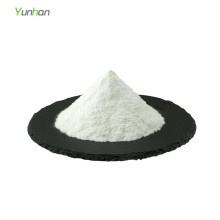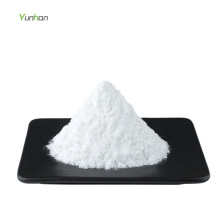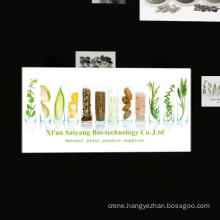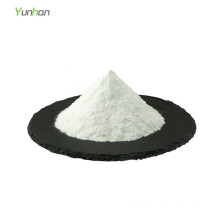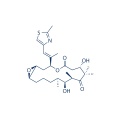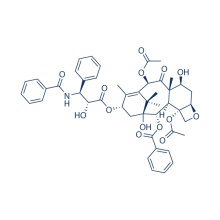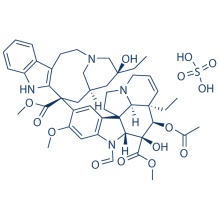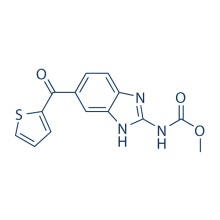Epothilone A 152044-53-6
Product Description
.cp_wz table {border-top: 1px solid #ccc;border-left:1px solid #ccc; } .cp_wz table td{border-right: 1px solid #ccc; border-bottom: 1px solid #ccc; padding: 5px 0px 0px 5px;} .cp_wz table th {border-right: 1px solid #ccc;border-bottom: 1px solid #ccc; padding: 5px 0px 0px 5px;}
Molecular Weight:
493.66 Epothilone A is a Taxol-like microtubule-stabilizing agent with EC0.01 of 2 μM.
Biological Activity
Epothilone A, discovered from the myxobacterium Sorangium cellulosum, is
a Taxol-like microtubule-stabilizing agent that induces tubulin
polymerization, leading to Cell Cycle arrest at the G2-M transition,
cytotoxicity, and Apoptosis.
Epothilone A potently inhibits cell proliferation in HCT116 cells, with
IC50 of 4.4 nM. Epothilone A also displays cytotoxicity in KB3-1,
KBV-1, Hela, and Hs578T cells, with IC50 values ranging from 13 nM to
160 nM. Epothilone A is more water soluble than Taxol and competes with
Taxol in binding with microtubules, with IC50 of 2.3 μM. However, both
Epothilone A and Taxol don't share a common pharmacophore and exploits
the tubulin-binding pocket uniquely and independently. Recently, it is
found that microbiological transformation of Epothilone A by Aspergillus
niger AS 3.739 yields several metabolites that is also toxic to MCF-7
cells, but with much higher IC50 values.
Protocol(Only for Reference)
Kinase Assay: [1]
Cell Assay: [2]
Conversion of different model animals based on BSA (Value based on data from FDA Draft Guidelines)
For example, to modify the dose of resveratrol used for a mouse (22.4 mg/kg) to a dose based on the BSA for a rat, multiply 22.4 mg/kg by the Km factor for a mouse and then divide by the Km factor for a rat. This calculation results in a rat equivalent dose for resveratrol of 11.2 mg/kg.
Chemical Information
Molarity Calculator
Dilution Calculator
Molecular Weight Calculator
Contact us if you need more details on 152044-53-6. We are ready to answer your questions on packaging, logistics, certification or any other aspects about Epothilone A 152044-53-6、152044-53-6 Epothilone A. If these products fail to match your need, please contact us and we would like to provide relevant information.
Molecular Weight:
493.66 Epothilone A is a Taxol-like microtubule-stabilizing agent with EC0.01 of 2 μM.
Biological Activity
Epothilone A, discovered from the myxobacterium Sorangium cellulosum, is
a Taxol-like microtubule-stabilizing agent that induces tubulin
polymerization, leading to Cell Cycle arrest at the G2-M transition,
cytotoxicity, and Apoptosis.
Epothilone A potently inhibits cell proliferation in HCT116 cells, with
IC50 of 4.4 nM. Epothilone A also displays cytotoxicity in KB3-1,
KBV-1, Hela, and Hs578T cells, with IC50 values ranging from 13 nM to
160 nM. Epothilone A is more water soluble than Taxol and competes with
Taxol in binding with microtubules, with IC50 of 2.3 μM. However, both
Epothilone A and Taxol don't share a common pharmacophore and exploits
the tubulin-binding pocket uniquely and independently. Recently, it is
found that microbiological transformation of Epothilone A by Aspergillus
niger AS 3.739 yields several metabolites that is also toxic to MCF-7
cells, but with much higher IC50 values.
Protocol(Only for Reference)
Kinase Assay: [1]
| Tubulin polymerization assay | Calf brain microtubule Proteins (MTP) are purified, which includes approximately 15%–20% microtubule associated proteins. The buffer (MES buffer) used for the Epothilone A-microtubule studies contains 0.1 M 2-morpholinoethanesulfonic acid (MES), 1 mM EGTA, 0.5 mM MgCl2, and 3 M glycerol at pH 6.6. Samples for electron microscopy are placed on carbon-over-Parlodion-coated grids (300 mesh) and negatively stained with 2% uranyl acetate. Microtubule assembly in the presence or absence of Epothilone A is monitored spectrophotometrically by using a spectrophotometer equipped with a thermostatically regulated liquid circulator. The temperature is held at 35 °C and changes in turbidity (representative of polymer mass) are monitored at 350 nm. Effective concentration (EC0.01), defined as the interpolated concentration capable of inducing an initial slope of 0.01 OD/min rate, is calculated using the formula EC0.01 = concentration/slope and expressed as the mean with standard deviation obtained from three different concentrations. |
|---|
Cell Assay: [2]
| Cell lines | KB3-1, KBV-1, Hela, and Hs578T cells |
|---|---|
| Concentrations | 0–2 μM |
| Incubation Time | 24 hours for mitotic arrest or 72 hours for cytotoxicity |
| Method | For mitotic block and aberrant mitosis, cells are plated either in 48-well plates (for trypan blue and cell counting) or onto coverslips. After 24 hours, cells are treated with Epothilone A and are scored at regular intervals. For the cytotoxicity analysis, cells are counted and scored as trypan blue positive or negative. Concurrently, coverslips and aliquots of cells in the culture supernatant are fixed and stained with Hoechst 33342 in PBS. These cells are scored for cells blocked at the G2-M transition and aberrant mitosis. |
Conversion of different model animals based on BSA (Value based on data from FDA Draft Guidelines)
| Species | Baboon | Dog | Monkey | Rabbit | Guinea pig | Rat | Hamster | Mouse |
| Weight (kg) | 12 | 10 | 3 | 1.8 | 0.4 | 0.15 | 0.08 | 0.02 |
| Body Surface Area (m2) | 0.6 | 0.5 | 0.24 | 0.15 | 0.05 | 0.025 | 0.02 | 0.007 |
| Km factor | 20 | 20 | 12 | 12 | 8 | 6 | 5 | 3 |
| Animal A (mg/kg) = Animal B (mg/kg) multiplied by | Animal B Km |
| Animal A Km |
For example, to modify the dose of resveratrol used for a mouse (22.4 mg/kg) to a dose based on the BSA for a rat, multiply 22.4 mg/kg by the Km factor for a mouse and then divide by the Km factor for a rat. This calculation results in a rat equivalent dose for resveratrol of 11.2 mg/kg.
| Rat dose (mg/kg) = mouse dose (22.4 mg/kg) × | mouse Km(3) | = 11.2 mg/kg |
| rat Km(6) |
Chemical Information
| Molecular Weight (MW) | 493.66 |
|---|---|
| Formula | C26H39NO6S |
| CAS No. | 152044-53-6 |
| Storage | 3 years -20℃Powder |
|---|---|
| 6 months-80℃in solvent (DMSO, water, etc.) | |
| Synonyms | |
| Solubility (25°C) * | In vitro | DMSO | 99 mg/mL (200.54 mM) |
|---|---|---|---|
| Water | <1 mg/mL ( | ||
| Ethanol | 99 mg/mL (200.54 mM) | ||
| * <1 mg/ml means slightly soluble or insoluble. * Please note that Selleck tests the solubility of all compounds in-house, and the actual solubility may differ slightly from published values. This is normal and is due to slight batch-to-batch variations. | |||
| Chemical Name | (1S,3S,7S,10R,11S,12S,16R,E)-7,11-dihydroxy-8,8,10,12-tetramethyl-3-(1-(2-methylthiazol-4-yl)prop-1-en-2-yl)-4,17-dioxa-bicyclo[14.1.0]heptadecane-5,9-dione |
|---|
Molarity Calculator
Dilution Calculator
Molecular Weight Calculator
Contact us if you need more details on 152044-53-6. We are ready to answer your questions on packaging, logistics, certification or any other aspects about Epothilone A 152044-53-6、152044-53-6 Epothilone A. If these products fail to match your need, please contact us and we would like to provide relevant information.
Product Categories : Cytoskeletal Signaling > Microtubule Associated Inhibitor
Other Products
Hot Products
Astragaloside AChlortetracycline HCl 64-72-2Paclitaxel 33069-62-4Dexamethasone Acetate 1177-87-3Dinaciclib (SCH727965) 779353-01-4CHIR-124 405168-58-3Ro3280 1062243-51-9TAME 901-47-3CCG-1423 285986-88-110058-F4 403811-55-2Dabigatran (BIBR 953) 211914-51-1H 89 2HCl 130964-39-5T0901317 293754-55-9Aprepitant 170729-80-3Turofexorate Isopropyl (XL335) 629664-81-9BMS-378806 357263-13-9
